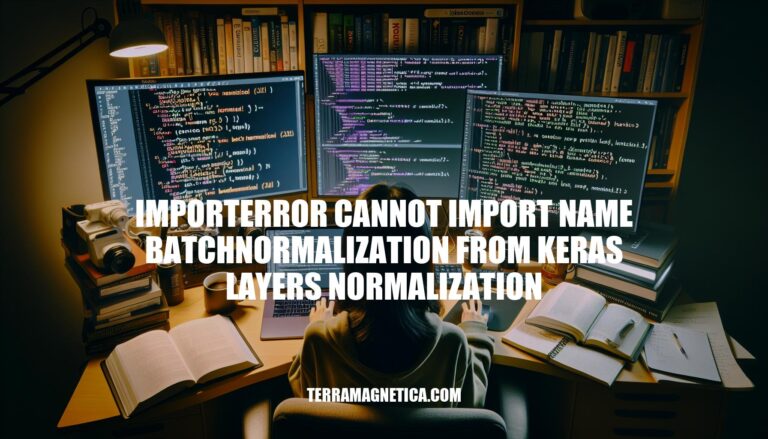


The ImportError: cannot import name 'BatchNormalization' from 'keras.layers.normalization' error typically occurs in TensorFlow and Keras environments due to changes in the module structure. This error often arises when the BatchNormalization layer is imported from an incorrect path. To resolve it, you should import BatchNormalization directly from keras.layers instead of keras.layers.normalization.
Would you like more details on how to fix this issue?
The ImportError: cannot import name 'BatchNormalization' from 'keras.layers.normalization' error typically arises due to:
Version Incompatibilities:
BatchNormalization is located in keras.layers instead of keras.layers.normalization.Incorrect Import Statements:
from keras.layers.normalization import BatchNormalization instead of from keras.layers import BatchNormalization.To resolve this, ensure you are using compatible versions of Keras and TensorFlow, and update your import statements to reflect the correct module paths.
When encountering the ImportError: cannot import name 'BatchNormalization' from 'keras.layers.normalization' issue, you might see the following symptoms and error messages in your code:
Error Message:
ImportError: cannot import name 'BatchNormalization' from 'keras.layers.normalization'
Symptoms:
BatchNormalization from keras.layers.normalization.Common Causes:
BatchNormalization module has been moved or renamed in the newer versions of Keras.BatchNormalization module in the specified path.Example Code Triggering the Error:
from keras.layers.normalization import BatchNormalization
Recognizing these symptoms and error messages can help you quickly identify and troubleshoot the issue in your code.
Here are some methods to resolve the ImportError: cannot import name BatchNormalization from keras.layers.normalization error:
Update TensorFlow/Keras:
pip install --upgrade tensorflow keras
Modify Import Path:
Replace:
from keras.layers.normalization import BatchNormalization
With:
from keras.layers import BatchNormalization
Use TensorFlow’s Keras:
from tensorflow.keras.layers import BatchNormalization
Check for Deprecated Modules:
Ensure you are not using deprecated modules. For example, keras.layers.normalization has been moved.
pip uninstall keras
pip install keras
pip install tensorflow==2.8 keras==2.8
These steps should help resolve the import error. If you encounter further issues, checking the specific version compatibility of TensorFlow and Keras might be necessary.
To avoid encountering the ‘ImportError: cannot import name BatchNormalization from keras.layers.normalization’ error in future projects, follow these best practices:
Version Management:
requirements.txt file to pin specific versions of your dependencies. For example:tensorflow==2.8.0
keras==2.8.0
venv or conda can help manage different environments for different projects.Regular Updates:
pip install --upgrade tensorflow keras
Import Statements:
from tensorflow.keras.layers import BatchNormalization
from keras.layers.normalization import BatchNormalization
Documentation and Release Notes:
Testing:
pytest to run your tests regularly.Code Reviews:
By following these practices, you can minimize the risk of encountering import errors and maintain a stable development environment.
To resolve the ‘ImportError: cannot import name BatchNormalization from keras.layers.normalization’ error, follow these steps:
To avoid encountering this error in future projects, practice version management by:
When working with Keras, it’s essential to be aware of breaking changes or deprecations in the libraries you use. Always refer to the official documentation and release notes for any updates.
To maintain a stable development environment, pin dependencies using a requirements.txt file, use virtual environments to isolate project dependencies, and regularly update packages.
In addition to these steps, implement automated tests to catch import errors early, and conduct code reviews to ensure adherence to best practices and catch potential issues. By following these practices, you can minimize the risk of encountering import errors and maintain a stable development environment.